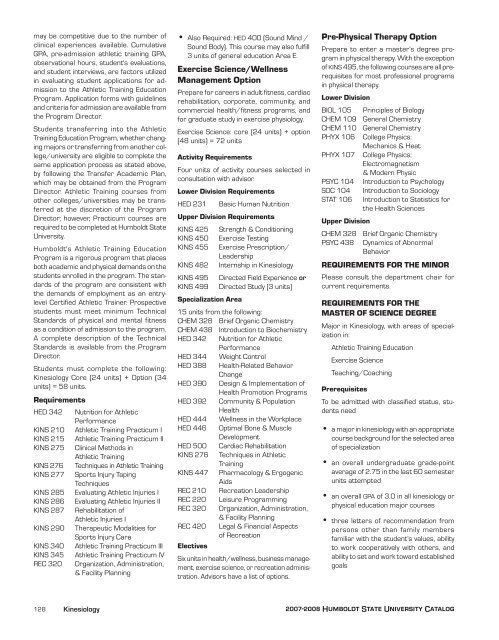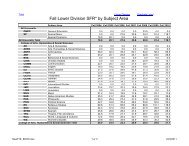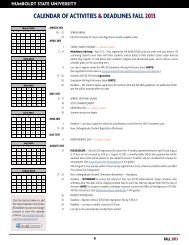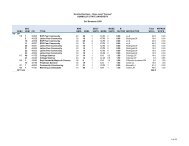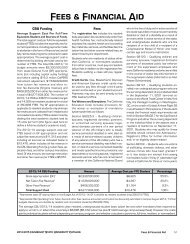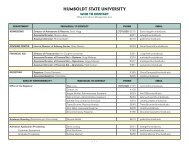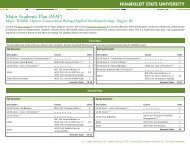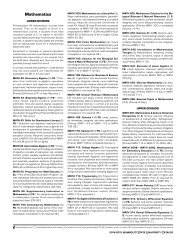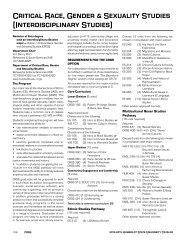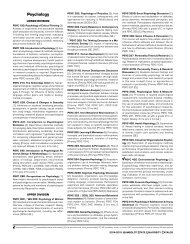2007-08 Academic Year - Humboldt State University
2007-08 Academic Year - Humboldt State University
2007-08 Academic Year - Humboldt State University
Create successful ePaper yourself
Turn your PDF publications into a flip-book with our unique Google optimized e-Paper software.
may be competitive due to the number of<br />
clinical experiences available. Cumulative<br />
GPA, pre-admission athletic training GPA,<br />
observational hours, student's evaluations,<br />
and student interviews, are factors utilized<br />
in evaluating student applications for admission<br />
to the Athletic Training Education<br />
Program. Application forms with guidelines<br />
and criteria for admission are available from<br />
the Program Director.<br />
Students transferring into the Athletic<br />
Training Education Program, whether changing<br />
majors or transferring from another college/university<br />
are eligible to complete the<br />
same application process as stated above,<br />
by following the Transfer <strong>Academic</strong> Plan,<br />
which may be obtained from the Program<br />
Director. Athletic Training courses from<br />
other colleges/universities may be transferred<br />
at the discretion of the Program<br />
Director; however, Practicum courses are<br />
required to be completed at <strong>Humboldt</strong> <strong>State</strong><br />
<strong>University</strong>.<br />
<strong>Humboldt</strong>'s Athletic Training Education<br />
Program is a rigorous program that places<br />
both academic and physical demands on the<br />
students enrolled in the program. The standards<br />
of the program are consistent with<br />
the demands of employment as an entrylevel<br />
Certified Athletic Trainer. Prospective<br />
students must meet minimum Technical<br />
Standards of physical and mental fitness<br />
as a condition of admission to the program.<br />
A complete description of the Technical<br />
Standards is available from the Program<br />
Director.<br />
Students must complete the following:<br />
Kinesiology Core (24 units) + Option (34<br />
units) = 58 units.<br />
Requirements<br />
HED 342<br />
KINS 210<br />
KINS 215<br />
KINS 275<br />
KINS 276<br />
KINS 277<br />
KINS 285<br />
KINS 286<br />
KINS 287<br />
KINS 290<br />
KINS 340<br />
KINS 345<br />
REC 320<br />
Nutrition for Athletic<br />
Performance<br />
Athletic Training Practicum I<br />
Athletic Training Practicum II<br />
Clinical Methods in<br />
Athletic Training<br />
Techniques in Athletic Training<br />
Sports Injury Taping<br />
Techniques<br />
Evaluating Athletic Injuries I<br />
Evaluating Athletic Injuries II<br />
Rehabilitation of<br />
Athletic Injuries I<br />
Therapeutic Modalities for<br />
Sports Injury Care<br />
Athletic Training Practicum III<br />
Athletic Training Practicum IV<br />
Organization, Administration,<br />
& Facility Planning<br />
• Also Required: HED 400 (Sound Mind /<br />
Sound Body). This course may also fulfill<br />
3 units of general education Area E.<br />
Exercise Science/Wellness<br />
Management Option<br />
Prepare for careers in adult fitness, cardiac<br />
rehabilitation, corporate, community, and<br />
commercial health/fitness programs, and<br />
for graduate study in exercise physiology.<br />
Exercise Science: core (24 units) + option<br />
(48 units) = 72 units<br />
Activity Requirements<br />
Four units of activity courses selected in<br />
consultation with advisor.<br />
Lower Division Requirements<br />
HED 231 Basic Human Nutrition<br />
Upper Division Requirements<br />
KINS 425 Strength & Conditioning<br />
KINS 450 Exercise Testing<br />
KINS 455 Exercise Prescription/<br />
Leadership<br />
KINS 482 Internship in Kinesiology<br />
KINS 495 Directed Field Experience or<br />
KINS 499 Directed Study [3 units]<br />
Specialization Area<br />
15 units from the following:<br />
CHEM 328 Brief Organic Chemistry<br />
CHEM 438 Introduction to Biochemistry<br />
HED 342 Nutrition for Athletic<br />
Performance<br />
HED 344 Weight Control<br />
HED 388 Health-Related Behavior<br />
Change<br />
HED 390 Design & Implementation of<br />
Health Promotion Programs<br />
HED 392 Community & Population<br />
Health<br />
HED 444 Wellness in the Workplace<br />
HED 446 Optimal Bone & Muscle<br />
Development<br />
HED 500 Cardiac Rehabilitation<br />
KINS 276 Techniques in Athletic<br />
Training<br />
KINS 447 Pharmacology & Ergogenic<br />
Aids<br />
REC 210 Recreation Leadership<br />
REC 220 Leisure Programming<br />
REC 320 Organization, Administration,<br />
& Facility Planning<br />
REC 420 Legal & Financial Aspects<br />
of Recreation<br />
Electives<br />
Six units in health/wellness, business management,<br />
exercise science, or recreation administration.<br />
Advisors have a list of options.<br />
Pre-Physical Therapy Option<br />
Prepare to enter a master’s degree program<br />
in physical therapy. With the exception<br />
of KINS 495, the following courses are all prerequisites<br />
for most professional programs<br />
in physical therapy.<br />
Lower Division<br />
BIOL 105 Principles of Biology<br />
CHEM 109 General Chemistry<br />
CHEM 110 General Chemistry<br />
PHYX 106 College Physics:<br />
Mechanics & Heat<br />
PHYX 107 College Physics:<br />
Electromagnetism<br />
& Modern Physic<br />
PSYC 104 Introduction to Psychology<br />
SOC 104 Introduction to Sociology<br />
STAT 106 Introduction to Statistics for<br />
the Health Sciences<br />
Upper Division<br />
CHEM 328 Brief Organic Chemistry<br />
PSYC 438 Dynamics of Abnormal<br />
Behavior<br />
REQUIREMENTS FOR THE MINOR<br />
Please consult the department chair for<br />
current requirements.<br />
REQUIREMENTS FOR THE<br />
MASTER OF SCIENCE DEGREE<br />
Major in Kinesiology, with areas of specialization<br />
in:<br />
Athletic Training Education<br />
Exercise Science<br />
Teaching/Coaching<br />
Prerequisites<br />
To be admitted with classified status, students<br />
need<br />
• a major in kinesiology with an appropriate<br />
course background for the selected area<br />
of specialization<br />
• an overall undergraduate grade-point<br />
average of 2.75 in the last 60 semester<br />
units attempted<br />
• an overall GPA of 3.0 in all kinesiology or<br />
physical education major courses<br />
• three letters of recommendation from<br />
persons other than family members<br />
familiar with the student’s values, ability<br />
to work cooperatively with others, and<br />
ability to set and work toward established<br />
goals<br />
128 Kinesiology<br />
<strong>2007</strong>-20<strong>08</strong> <strong>Humboldt</strong> <strong>State</strong> <strong>University</strong> Catalog


